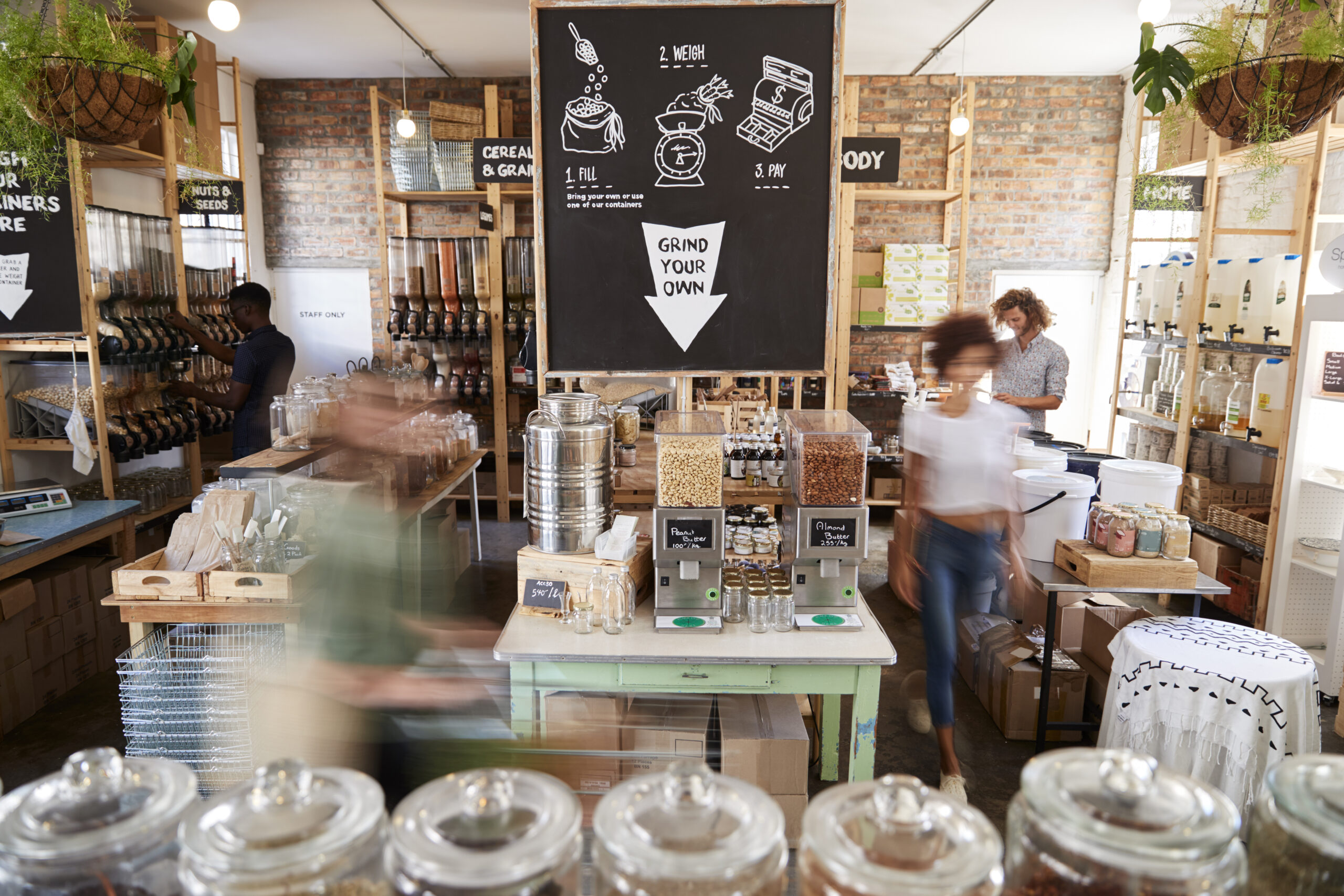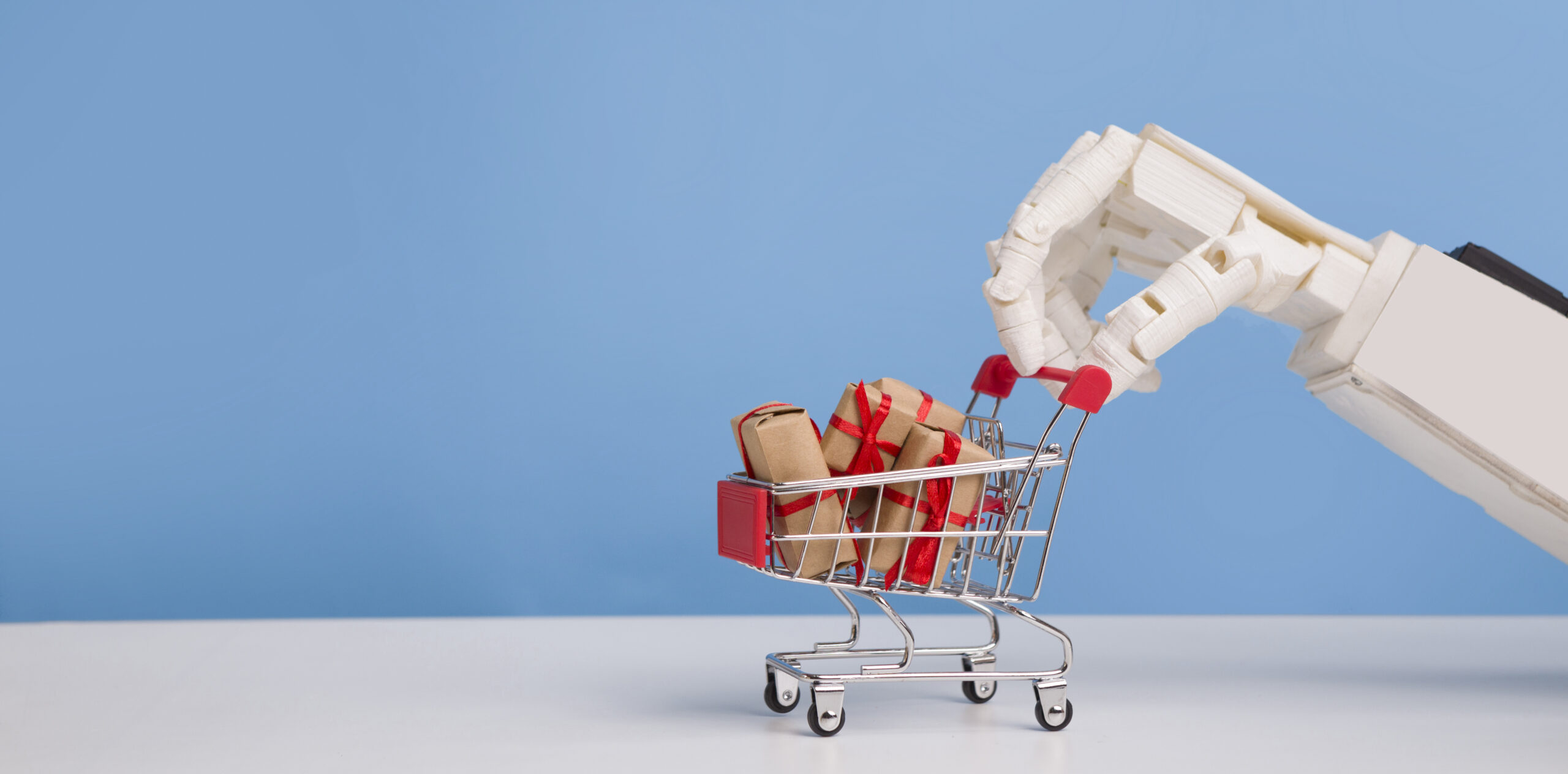Future-Forward Branding: Top 10 Consumer Trends Set to Define 2024
2023 has undoubtedly been a whirlwind of a year for both consumers and retailers. From the dawn of AI to spiralling cost of living pressures – via an unexpected Barbie comeback – the pace of change has been frenetic for both brands and shoppers alike.
But it’s nearly Christmas, and that means it’s time to take a breath, slow down for a moment, and reflect on the year that’s been, as well as the year to come (ideally over a well-deserved Baileys).
As 2023 finally winds down, it’s fair to say we’re all a bit exhausted, ready to eat our own bodyweight in Lindt, and just forget about it all for a blissful few days.

But when January inevitably hits like a bleak and blustery slap in the face (why is January even allowed still?) we’ll all need to come to terms with the fact that 2023 fundamentally shifted the known consumer landscape in completely unexpected ways, and at unprecedented speeds.
For brands and businesses across the board, looking ahead to 2024 now means getting ready to adapt and reposition faster than ever just to keep up. Best get moving…
A Year In Consumer Connections: Insights Across The Sector
At Bolt, we’ve spent the year with our finger firmly on the proverbial pulse, running quant and qual consumer research studies across industries from fashion to finance, exploring topics from AI to Sustainability.
We’ve connected directly with consumers from all walks of life, both through the social media platforms they’re interacting on, as well as directly via AI-powered chat.
And from the thousands of interviews and chats we’ve conducted; we’ve been able to uncover the key emerging trends and shifts set to shape the consumer landscape in 2024.
In this article, well unpack the top 10 must-know consumer trends that are set to define consumer behaviour and impact brand strategies into 2024 – and beyond.
So let’s get into it…
Top 10 2024 Consumer Trends:
1. AI: The Human Connection Conundrum
There’s no doubt that AI has been the trend of 2023. But beyond its obvious potential for optimising efficiencies for almost any type of brand or business, whether or indeed how it’s set to enhance the customer experience – and in turn build trust and loyalty among consumers – is less certain.
In a Bolt Insight study on consumer attitudes towards Artificial Intelligence conducted this year, people expressed mixed – and at times conflicting – feelings about AI.
While 50% expressed excitement about AI in general, particularly when it came to automating menial and manual repetitive tasks, almost 50% said the threat of reduced human interaction was their top concern as AI rolls out across businesses and society.

To Bot, or not?
And it’s true that what’s of concern – is also inherently of value. When asked what they wanted from businesses in 2024, one thing stood out above all else.
Customers want genuine, meaningful connections with the businesses they buy from. And they value this above almost all else.
If a customer has a problem, often they want to know they can speak to a real person. Additionally, all customers want to feel valued – and just getting routed down an impersonal customer service automation funnel doesn’t always meet this need…
A customer who feels valued – is a customer who will return, and down the line become a loyal advocate, rather than just another churn-rate stat.
Brands therefore need to strike a delicate balance between strategic automation – and maintaining the meaningful human touch where needed.
No Loyalty without Trust:
Trust in AI is also still fragile. Among those with a basic understanding of AI (still very much the majority of people), just 25% said they trusted it. Concerns around safety, privacy, and a lack of accountability are the key drivers for a generally fear-based attitude towards AI at present.
If customers feel they are being forced to interact with an AI-generated automaton agent inexplicably called Susan as the gatekeeper of a brand’s customer service in the name of cost-savings – research shows they’ll likely vote with their feet – and move elsewhere.
Brands need to maintain human connection at the heart of their AI adoption, harnessing the technologies advantages, while keeping customers loyal with exceptional service and a human touch.
2. Affordable Luxury: Leveraging the Lipstick Effect

In an investigative study into the phenomenon known as the Lipstick Effect – a phenomenon where consumers tend to prioritise smaller luxury items during periods of economic downturn – our research revealed that over 1 in 3 women had spent considerably more on beauty products over the course of the cost of living crisis.
Why? Because small items like lipstick provide a sense of indulgence, but are seen as affordable treats, even when financial times are hard.
The cost of living crisis isn’t going anywhere. As inflation persists and squeezed consumer budgets rumble on into 2024, the Lipstick Effect will continue to play out well into next year.
As we all wrestle with the existential decision of how long to put the heating on for over the inevitable January cold snap, the need to treat ourselves – in whatever ways we still can – remains.
So – what specific strategies can brands implement in 2024 to leverage the ongoing Lipstick Effect?…
Target Younger Generations:
The Lipstick Effect is most prevalent among younger Gen-Z’ers. Our recent study showed that 18–24-year-olds are significantly more likely to have spent more on small luxuries than any other age group throughout the cost of living crisis.
So for maximum impact, brands should focus their small but affordable luxury based promotions predominantly on appealing to Gen-Z customers.
And don’t forget – make it small, make if affordable.
Create Limited Edition Collections:
With the impulse of the Lipstick Effect being triggered by seemingly affordable luxury, brands can leverage the power of limited-edition collections of micro-luxury items – with unique packaging or trendy designs.
Create a sense of exclusivity, luxury, and urgency. We know that limited-edition products generate 2.6 times more revenue per item than regular products, so tap into the power of the Lipstick Effect for your brand with an exclusive, limited-edition range.
3. For brands, social and environmental responsibility won’t just be a matter of positioning – but of survival

The consumer landscape is evolving. People expect more than just low prices and business as usual from the brands they use. Consumers are prioritising ethics over discounts, and the brands that don’t align with this will struggle to gain traction.
Our recent research into sustainability’s impacts on brand loyalty revealed that 65% of consumers would likely stop using a brand if it became associated with negative environmental impacts or not paying supply chain workers a fair wage.
It seems that, as we head into 2024, brands have more than their reputations to lose if they continue to operate unsustainably.
Brands have to raise the bar, but can also raise prices, where appropriate:
Our research showed Gen-Z & Millennials are putting their money where their mouth is when it comes to sustainability, with 40% being prepared to pay between £5-£15 more for sustainable items.
However, this willingness to pay more for items sourced and made in ethical and sustainable ways tapers off as you go up the generations – as 40% of Gen-X shoppers said they wouldn’t fork out anything extra. And for Boomers – this goes up to 60%.
When it comes to setting premium prices points for sustainable items, brands must be sure to target their price for the right items, aimed at the right generations, with the corresponding values to back up price hikes to cover the increased supply chain costs for sustainable items.
The Brands leading with strong values will be the winners:
The significance of companies adopting positions on social issues has heightened, exerting a greater influence on consumers’ choices when making purchases.
Our research shows that 54% of adults believe that brands ought to intensify their engagement in social advocacy.
Gen-Z in particular are increasingly supporting brands strongly focused on diversity and inclusion, with 1 in 4 saying that a brand’s dedication to diversity and inclusion ranks among the top factors influencing their purchasing decisions.
With 42% of consumers now more likely to buy a product based on a brand’s dedication to diversity – it’s clear that from 2024 onwards, the brands that lead with strong values will build trust, loyalty, and advocacy over those that don’t take a stand on the core issues that matter to their customers.
4. Private Labels are coming for the brands that stand still…

In our recent study into how cost of living pressures are impacting consumer behaviour, one thing became clear – shoppers are turning to private label brands in ever increasing numbers.
Not only that – but the perception of private labels being a cheaper, but lower quality alternative is shifting, with 75% of consumers perceiving Private Label products as being of similar or superior quality to branded products.
From food to beauty and healthcare, no sector is safe from the rise of private labels. Whatever industry they’re operating in – brands need to sit up and take notice.
So what can they do to mitigate the increasing market share of private label products? Luckily, we’ve done some digging…
Double down on service, brand values, and identity:
Marketers have long known that the real driver behind seemingly rational decisions such as what product or brand to buy are really just the surface reflections of subtle unconscious emotional reactions.
Time and again in our research, consumers show us it’s not just the cheapest, fastest, or easiest brand or product they want. People want human connection in their interactions with brands, not just faceless automation.
They want to feel that their choice of brands reflect who they are, and what they stand for.
And they will stand by and remain loyal to brands that reflect their social and environmental values, and – for Gen-Z at least – pay more for items that are sustainable and ethical.
Offset Private Label Savings with Premium Promotions:
The cost of living crisis has proven to be a catalyst for cost-conscious consumers making the switch to private labels. But we already know about the pull of affordable luxury in times of trouble.
Exclusive promotions for the small luxirious products will prove to be irresistible – drawing in new and existing customers, who can then be targeted with personalised marketing and upsells to shore up A-brand advocates, and build a solid customer base of loyalty and retention in the process.
The social and emotional value of a brand will continue to grow in importance in 2024, as people look more towards what a brand means to them personally, rather than just being a means to a purchase end.
A-brands that position themselves correctly, and with authenticity, will be uniquely positioned to benefit from this shift.
5. Boomers are shopping online more than ever – and brands need to be seizing the opportunity

Let’s face it – queuing for an hour outside Aldi in a face mask while over-zealous security operated a 1-in 1-out policy like some kind of dystopian retail nightclub was a low point of the pandemic for all of us.
Given this, it’s little surprise that Boomers – not known as keen online shoppers before the pandemic – turned to online channels for their basic shopping,
And it’s a trend that’s not only continued since, but continued to grow – exponentially.
While Gen-Z are always an in-demand group, its actually Boomers who currently command the greatest spending power, with savings and credit cards ready to go.
So – Boomers are scrolling and buying online more. And they have cash to spare. How do we take this and add it to our arsenal of strategies to succeed in 2024?
Make them feel understood, and engage across channels:
Boomers report that they often feel somewhat excluded from brand advertising. With so much focus on Gen-Z and even millennials, Boomers can often get lost in the fray. But given that they’re being increasingly drawn into the digital economy, brands would do well to ensure Boomers are included in their 2024 marketing strategies.
If brands can make them feel more understood, they’ll naturally engage more with their campaigns and messaging.
So there’s a lot to gain from engaging with Boomers – but not just on traditional channels. Brands need a multi-channel approach foe engaging, including social platforms.
While Facebook is still the most popular among older generations, it turns out our nans are also getting to grips with TikTok – which has seen a near 60% increase in Boomer use this year, while Instagram is now the second most popular social app among older generations.
6. Hyper-Personalisation: The key to meeting elevated expectations
In the digital marketing landscape, personalization is no longer a choice; it’s a crucial strategy for brands aiming to engage and retain customers.
With evolving and elevated customer expectations, innovating personalisation is vital for creating experiences that meet these new expectations. From product recommendations to tailored suggestions, marketing, and experiences, the possibilities for personalisation are evolving as fast as the technologies that drive it.
And the brands that can leverage it effectively can make their customers feel valued, understood, and personally catered to. All good things in the endlessly competitive landscape for attention and loyalty.
So how can brands utilise this key emerging consumer trend in 2024?
AI-Powered Personalisation:
In the endless digital world, AI-powered personalisation is a game-changer. Whether picking movies or shopping online, AI recommendation engines tackle the choice overload affecting our already digitally frazzled brains, making customers happier (or at least less overwhelmed and exhausted), and brands more able to serve individual needs and interests.
Forward thinking businesses are already cottoning on to AI’s potential to optimise personalisation. The key lies in utilising it to efficiently analyse vast amounts of customer data, identify meaningful patterns, and deliver tailored content using machine learning.
Make it Personalised, but make it Hyper:
It feels like everything has to be hyper these days. Hyper fast, hyper efficient, hyper scalable. Where does it end?
But hyper-personalised? Well – maybe that’s something we can all get on board with.
Hyper-personalisation is all about tailoring the customer experience at every touchpoint. It involves dynamic, data-driven approaches like personalized recommendations, marketing messages, and pricing.
AI and machine learning refine understanding, enabling real-time adjustments to the process, while acknowledging each customer’s unique preferences and interests. Pretty cool…
But is it worth it? Well in short – all initial readings point to a resounding yes. So far, the brands that are investing in the right tech and get hyper-personalisation right are seeing revenue uplifts of up to 20%, greater loyalty among existing customer bases, and enhanced customer engagement with (personalised, of course) content and messaging.
7. Consumers are prioritising lasting value over short-term discounts
With over 40% of mortgage holders set to see increases in their monthly payments in 2024, and multiple cost of living pressures such as rapid inflation of grocery and FMCG products denting consumer spending power, it’s no surprise that we’re seeing a clear trend towards people becoming more savvy, and selective about what and where they spend their money.
Consumers are increasingly becoming ‘value hackers’ – seeking discounts without compromising quality. Premium private label brands, vouchers and promotions are all giving them the opportunity to have the best of both, as they look to offset the squeeze on personal finances.
With over 40% of 18-30s having to cut back on the bare essentials, it’s time for brands to recognise and adapt to this reduced consumer spending power in 2024. But how?
Focus on Quality:
The old adage – buy once, buy well – is one that some savvy consumers are adopting. Many recognise that while buying quality may mean spending more on day one, down the line – the savings can be considerable, as the need to replace poor quality items repeatedly never arises.
Brands should focus their messaging on durability, quality, ‘buy for life’ type campaigns to reassure shoppers that the price point is justified, represents a long term saving, and convince them to part with their hard earned cash.
Become a trusted ally by highlighting sustainability:
Consumers now want to engage with brands that meet them with authenticity, and strong values that reflect their identity and ethical priorities.
With 49% of consumers being confused about the issue of sustainability in the products they buy, brands can position themselves as trusted leaders by clearly speaking out on the issues and challenges around sustainability, and leading with authority.
Clear messaging about how buying once and buying quality products reduces carbon footprint across the pre-and-post supply chain will help them not only build trust and justify the required price points, but also help brands position themselves as authoritative allies on the social and environmental issues that are emerging as pivotal factors for consumers.
8. Digital Disruption is the New Normal

From Airbnb to Uber to Amazon, our age has been one of continual and seismic digital disruption continually redefining the playing field.
AI is arguably just this year’s example. Digital disruption isn’t something to navigate through – but to embrace, integrate, and ultimately capitalise on.
Socio-economic factors can play a role, as of course do technological advances. The pandemic shifted Boomers more online, while in a recent Bolt Insight finance study, it was revealed that the cost of living crisis is increasingly shifting young people away from traditional banks towards Neobanks and Challenger banks like Monzo and Revolut.
In fact, a recent study we conducted into Financial Behaviours of 18-30 year-olds showed nearly 25% of young people in the UK now primarily use Neobanks for their personal finance, with the budgeting features, ease-of-use, and mobile integration helping them to better manage their finances.
No one wants to spend their lunch hour queuing in Natwest anymore. And who can blame them…
So how to stop disruption turning into downfall?…
Embrace New Tools and Technologies:
And don’t just embrace – actively seek out, test, integrate, and throw yourself into researching, exploring, and adopting new tools, technologies, and solutions.
This whole AI thing? Dedicate resources to working out exactly how to utilise it to scale, become more efficient, and understand and serve your customers better.
Don’t be afraid of radical innovation. The brands that move fast – fail fast, learn first, and can then build back stronger and wiser.
Become the disruptor, not the disrupted:
Innovation and action-taking ‘move fast and break things’ attitudes of early adoption are the first steps to disrupting an industry.
Here at Bolt, we’ve already developed, tested, and rolled out the world’s first AI-powered qualitative research tool, eliminating the traditional barriers of operational heavy lifting and time-consuming analysis that have long limited qualitative research.
9. Big, traditional Christmas Campaigns still pack a seasonal punch as we move into 2024

Seeing as it’s December, it wouldn’t be right not to mention the Big One. Namely – Christmas.
We recently conducted a BoltChatAI study into consumer reactions to several flagship brands’ ads in both the UK and the US.
And across the generations, what was clear was that if brands can get it right, hitting people hard in the seasonal feels is a great way of cementing positive brand associations, and shoring up brand loyalty, with a clear correlation between a successful Christmas Ad and customer purchase intent.
Know the Audience – know the Emotion:
Our study revealed that both young and old experienced good feelings when watching the ads. But beyond that, when it comes to generational differences, the details differ.
While Gen-Z’ers mostly felt feelings of anticipation and excitement for upcoming Christmases, older generations mostly felt feelings of happy nostalgia. While Gen-Z looked forward, others looked back.
Knowing this emotional dynamic can help brands to refine the emotional tone of their ads depending on the demographic they want to appeal to.
Align the Campaign with Your Values:
While most of the ads were well-received, the study showed that people are sensitive to ad campaigns that don’t align with a brands’ image or values correctly.
While people are definitely keen to get on board with the good Christmas feelings, and welcome the ads that bring them, they’re also keen to notice when it feels like brands are opportunistically highjacking Christmas with ads that don’t align with their usual core messaging and values.
But even in this digitised doom-scrolling world it can sometimes feel like we live in, it seems that the traditional Christmas spirit and values are alive and well in people of all ages.
And for the brands that get it right – the traditional large, omni-channel Christmas ads that tap into it will build brand affinity, loyalty, and positive associations, from Gen-Z to Boomers.
10. Brands need to continually listen to and understand their customers – now more than ever

With the pace of change seen in 2023, the consumer landscape is shifting faster than ever. What was true or valid before the pandemic, or pre-AI, or before we saw the cost of living crisis coming, may now be obsolete, or forever morphed into something unrecognisable.
Expectations, priorities, and realities are just now catching up with the large scale technological and socio-economic shifts we’ve seen in 2023.
It’s now more important than ever that brands conduct continuous research and analytics to truly understand their customer’s ever evolving and complex needs and wants.
As we’ve seen – if a brand can make a customer feel valued, understood, and provide authentic human connection where it matters – then they will thrive, whatever shifts come in 2024.
And in order to meet their customers there – brands need to listen up – and take on board what they’re saying.
But consumer feedback has become ever more diffuse, spread across different channels and mediums. While taking an omni-channel approach to CX will go a long way to helping brands fix what needs fixing, proactively conducting customised research and meaningful consumer connections will be what gives brands the understanding needed to truly stay ahead.
Brands should listen in, sense check, and get continuous feedback at every stage of an idea, concept, or campaign – or they risk missing the mark, going off course, or just getting lost in the noise.
Key Takeaways:
As we navigate through 2024, the consumer landscape is undergoing a profound transformation shaped by the interplay of various factors.
The cost of living crisis has heightened the importance of value-based choices, with consumers scrutinizing every purchase for its impact on their budget. AI and digitization continue to streamline and personalize the consumer experience, yet the human touch and authenticity remain paramount.
The “lipstick effect” persists, revealing the resilience of consumer behavior during economic uncertainties. Moreover, the call for sustainability and ethical values in products has evolved from a trend to a core expectation.
In this dynamic environment, businesses must recognize the imperative of meaningful market research to understand and adapt to these multifaceted shifts. Staying attuned to the pulse of consumer preferences is not just a strategy; it’s a necessity for those seeking to thrive in an era where choices are as diverse as the values that guide them.
Right – we’re off to binge eat Lindt and crack open the Baileys. See you on the other side. in the cold dawn of January – but this time – handily armed with the key strategies to ensure successful Future Forward Branding in 2024!
Interested in running your own study? Get in touch to discover how Bolt’s digital insight solutions and AI-powered qualitative research can help you gain the market intelligence needed to help supercharge your growth, next product launch, or upcoming campaign.













